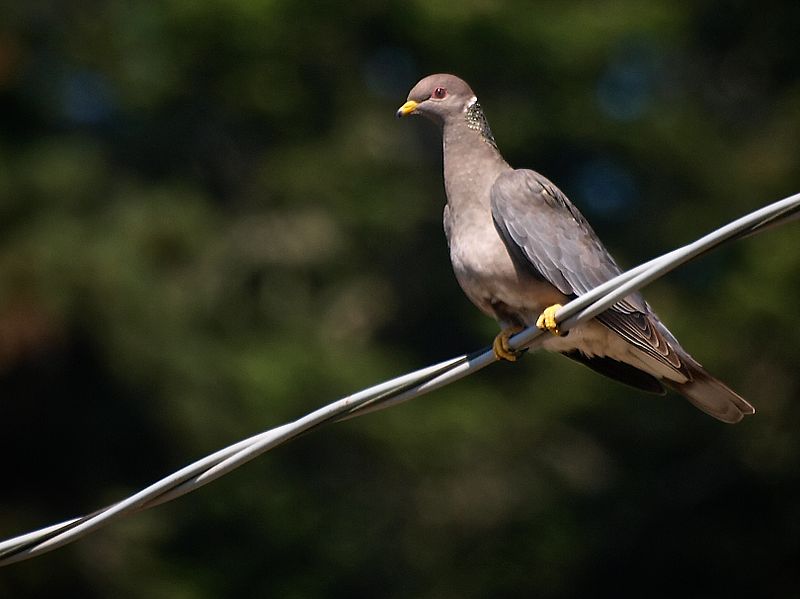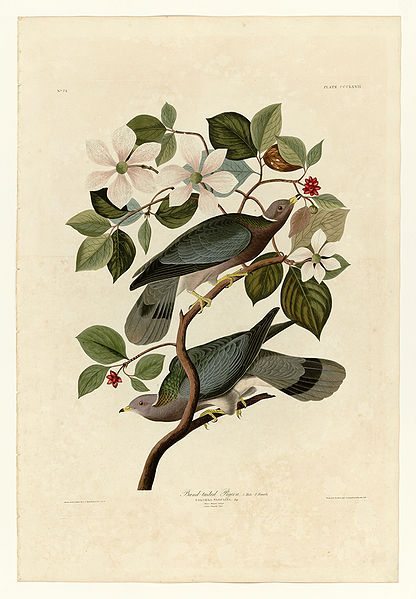New clues to a Band-tailed Pigeon mystery
By Jack Dumbacher
In recent months, I’ve seen and heard many Band-tailed Pigeons around my house in Marin. Their burst of slapping wing beats can surprise me if I flush them from a low perch, or I might hear their resounding call drifting down from a perch high in the redwoods. I always appreciate hearing or seeing them, as their populations overall have been in decline for many years.
These pigeons have posed a conservation puzzle. Although their populations have been declining at a rate of about 2.8-3.0 percent range-wide for multiple decades, no one has known the reason why [1]. Just to put that into perspective, a 2.8 percent decline will reduce a population to under one quarter of its original size in 50 years time. And Band-tailed populations are already much lower than historical numbers, although no reliable data exists to say just how much.
In 1913, U.C. Berkeley’s own Joseph Grinnell wrote an article for The Cooper Ornithological Society’s journal, the Condor, about the bleak future of the Band-tailed Pigeon as a game bird in the western United States [2]. In fact, the Band-tailed Pigeon offers striking parallels with the Passenger Pigeon. They lay a single egg, they follow boom-and-bust cycles of acorns and other fruits, there are certain times of year – mostly winter – when they congregate in large numbers, and it is difficult to predict exactly where the larger winter flocks will reside.

In the winter of 1911-1912, the birds were so common in San Luis Obispo and Santa Barbara that hunters arrived by trainloads and hunted the birds, Passenger Pigeon style. The concern of W. Lee Chambers [3], Grinnell, and others led to a ban on hunting that lasted until the early 1930s.
As the numbers began to rebound, farmers complained of crop damage and continued to hunt them. Especially in winter, flocks would appear large and destructive in California, mostly because the bulk of the western races (Patagioenas fasciata monilis) would gather and overwinter here. However, there was little evidence that they actually damaged crops during these months [1]. Band-tailed Pigeons are still legal to hunt in California, but limits are low and this is not believed to have a negative impact on their population.
We now know why the Band-tailed Pigeon’s biology resembles the Passenger Pigeon’s: They turn out to be each other’s closest genetic relatives. And it seems uncanny that Grinnell should write an article calling for Band-tailed Pigeon conservation on the eve of the extinction of its sister species. The article by Grinnell likely helped save the Band-tailed from extinction, but even without clearly identifiable threats, the pigeons are still in decline.

In recent months, an interesting new discovery may have identified one important threat and potential cause of the declines. Researchers from U.C. Davis and the California Department of Fish and Wildlife have been studying multiple significant Band-tailed Pigeon mortality events in California and associated pathologies. A newly described species of flagellated protozoan parasite, Trichomonas stableri, is responsible for several major die-offs [4, 5] such as one that killed an estimated 43,000 Band-tailed Pigeons in 2007 in Carmel [6].
The pathogen causes lesions in the mouth and esophagus that can obstruct feeding and breathing, and lead to starvation and suffocation. Other strains of Trichomonas are ubiquitous in nature and not uncommon in pigeons, but they may not be quite as pathogenic as T. stableri.
Evidence is mounting that these Trichomonas diseases are contributing to the steady decline in Band-tailed Pigeons, as well as to the massive mortality events [7]. Who knows – diseases like this may have even contributed to the extinction of the Passenger Pigeon. And this could be a major lead in trying to figure out how to help Band-tailed Pigeon populations stabilize or increase.
We are lucky to live in the Bay Area where Band-tailed Pigeons breed and can be found year-round. Despite the fact that flock sizes are now typically small, we can still marvel at our last remaining large forest pigeons. Perhaps one day their growing populations might help us better imagine what a flock of Passenger Pigeons must have been like.
———————————–
1. Keppie, D.M. and C.E. Braun, Band-tailed Pigeon (Patagioenas fasciata), in The Birds of North America Online, A. Poole, Editor. 2000, Cornell Lab of Ornithology: Ithaca, NY.
2. Grinnell, J., The Outlook for Conserving the Band-Tailed Pigeon as a Game Bird of California. The Condor, 1913. 15(1): p. 25-40.
3. Chambers, W.L., Who will save the Band-tailed Pigeon? The Condor, 1912. 14(3): p. 108.
4.Girard, Y.a., et al., Trichomonas stableri n. sp., an agent of trichomonosis in Pacific Coast band-tailed pigeons (Patagioenas fasciata monilis). International Journal for Parasitology: Parasites and Wildlife, 2014. 3(1): p. 32-40.
5. Girard, Y.a., et al., Dual-pathogen etiology of avian trichomonosis in a declining band-tailed pigeon population. Infection, Genetics and Evolution, 2014. 24: p. 146-56.
6. Stromberg, M. R. et al., Estimate of Trichomonas gallinae-induced Mortality in Band-tailed Pigeons, Upper Carmel Valley, California, Winter 2006–2007. The Wilson Bulletin. The Wilson Journal of Ornithology, 2008. 120(3): p. 603-606.
7. Lawson, B., et al., A clonal strain of Trichomonas gallinae is the aetiologic agent of an emerging avian epidemic disease. Infection, Genetics and Evolution, 2011. 11(7): p. 1638-1645.
———————————–
Jack Dumbacher is on the GGBA Board of Directors and chairs its San Francisco Conservation Committee. Chair of the Department of Ornithology and Mammalogy at California Academy of Sciences, Jack is author of more than two dozen scholarly articles on birds. In July, he wrote for the GGBA blog about Making the case for biodiversity.
